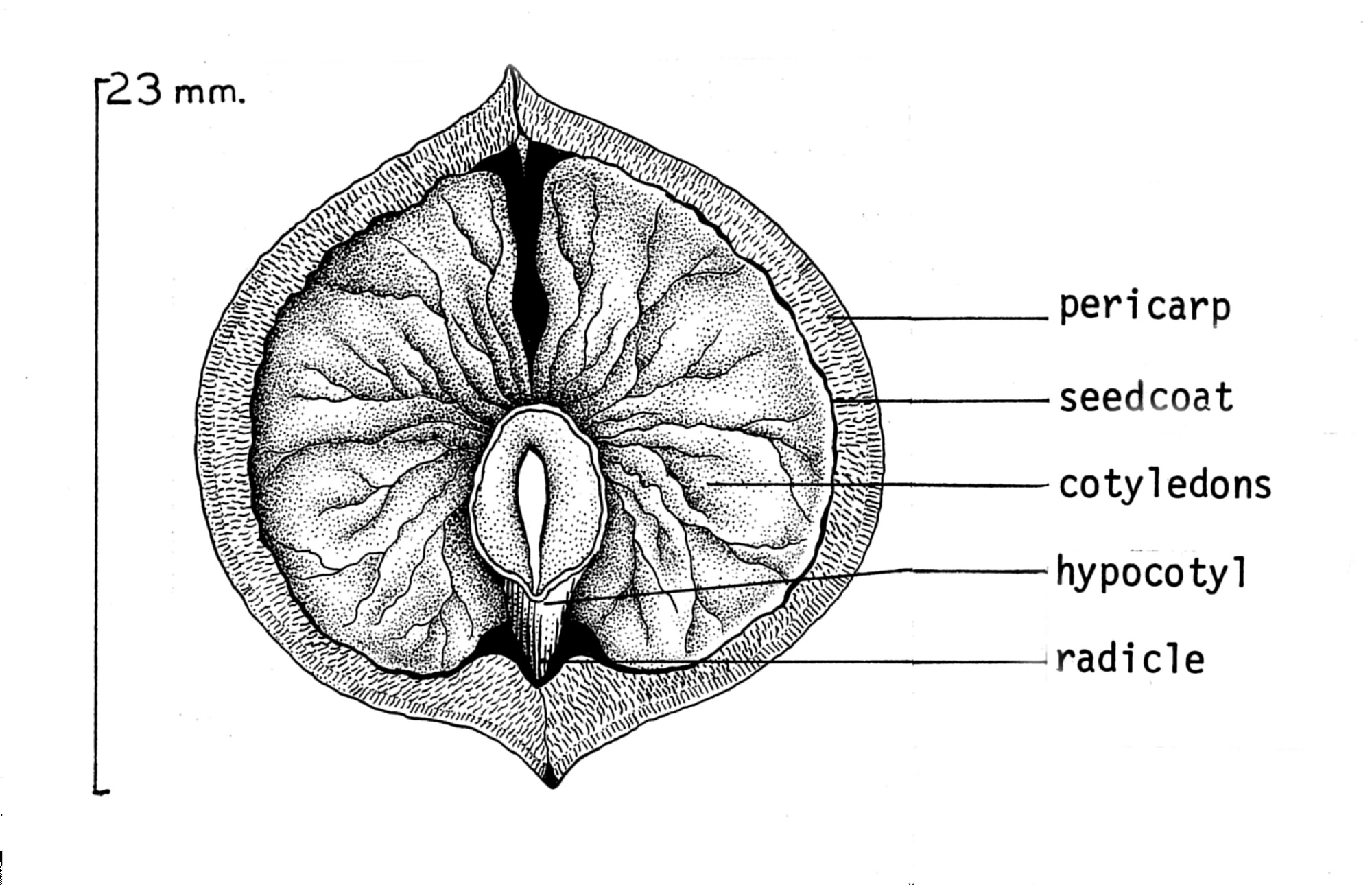|
Common Walnut
''Juglans regia'', known by various common names including the common walnut, English walnut, or Persian walnut amongst other names, is a species of walnut. It is native to Eurasia in at least southwest and central Asia and southeast Europe, but its exact natural area is obscure due to its long history of cultivation. The species has numerous cultivars which produce the edible walnut consumed around the world and produced predominately in China. It is widely cultivated across temperate regions throughout the world including those of Eurasia, Australia, and the Americas. Etymology The genus name, ''Juglans,'' is derived from two Latin words, ''jovis'', which means Jupiter, the chief god of the ancient Roman religion; and ''glans'' meaning an acorn or nut. The specific epithet, ''regia,'' is defined as regal or royal in references the quality of the fruit and edible nuts. Description ''Juglans regia'' is a large deciduous tree, attaining heights of , and a trunk up to in d ... [...More Info...] [...Related Items...] OR: [Wikipedia] [Google] [Baidu] |
The IUCN Red List Of Threatened Species
The International Union for Conservation of Nature (IUCN) Red List of Threatened Species, also known as the IUCN Red List or Red Data Book, founded in 1964, is an inventory of the global conservation status and extinction risk of biological species. A series of Regional Red Lists, which assess the risk of extinction to species within a political management unit, are also produced by countries and organizations. The goals of the Red List are to provide scientifically based information on the status of species and subspecies at a global level, to draw attention to the magnitude and importance of threatened biodiversity, to influence national and international policy and decision-making, and to provide information to guide actions to conserve biological diversity. Major species assessors include BirdLife International, the Institute of Zoology (the research division of the Zoological Society of London), the World Conservation Monitoring Centre, and many Specialist Groups within th ... [...More Info...] [...Related Items...] OR: [Wikipedia] [Google] [Baidu] |
Leaves
A leaf (: leaves) is a principal appendage of the stem of a vascular plant, usually borne laterally above ground and specialized for photosynthesis. Leaves are collectively called foliage, as in "autumn foliage", while the leaves, stem, flower, and fruit collectively form the shoot system. In most leaves, the primary photosynthetic tissue is the palisade mesophyll and is located on the upper side of the blade or lamina of the leaf, but in some species, including the mature foliage of ''Eucalyptus'', palisade mesophyll is present on both sides and the leaves are said to be isobilateral. The leaf is an integral part of the stem system, and most leaves are flattened and have distinct upper ( adaxial) and lower ( abaxial) surfaces that differ in color, hairiness, the number of stomata (pores that intake and output gases), the amount and structure of epicuticular wax, and other features. Leaves are mostly green in color due to the presence of a compound called chlorop ... [...More Info...] [...Related Items...] OR: [Wikipedia] [Google] [Baidu] |
Theophrastus
Theophrastus (; ; c. 371 – c. 287 BC) was an ancient Greek Philosophy, philosopher and Natural history, naturalist. A native of Eresos in Lesbos, he was Aristotle's close colleague and successor as head of the Lyceum (classical), Lyceum, the Peripatetic school, Peripatetic school of philosophy in Athens. Theophrastus wrote numerous treatises across all areas of philosophy, working to support, improve, expand, and develop Aristotelian system, the Aristotelian system. He made significant contributions to various fields, including ethics, metaphysics, botany, and natural history. Often considered the "father of botany" for his groundbreaking works "Historia Plantarum (Theophrastus), Enquiry into Plants" () and "On the Causes of Plants", () Theophrastus established the foundations of Botany, botanical science. His given name was (Ancient Greek: ); the nickname Theophrastus ("divine speaker") was reputedly given to him by Aristotle in recognition of his eloquent style. He came to ... [...More Info...] [...Related Items...] OR: [Wikipedia] [Google] [Baidu] |
Alexander The Great
Alexander III of Macedon (; 20/21 July 356 BC – 10/11 June 323 BC), most commonly known as Alexander the Great, was a king of the Ancient Greece, ancient Greek kingdom of Macedonia (ancient kingdom), Macedon. He succeeded his father Philip II of Macedon, Philip II to the throne in 336 BC at the age of 20 and spent most of his ruling years conducting Wars of Alexander the Great, a lengthy military campaign throughout West Asia, Western Asia, Central Asia, parts of South Asia, and ancient Egypt, Egypt. By the age of 30, he had created one of the List of largest empires, largest empires in history, stretching from History of Greece, Greece to northwestern History of India, India. He was undefeated in battle and is widely considered to be one of history's greatest and most successful military commanders. Until the age of 16, Alexander was tutored by Aristotle. In 335 BC, shortly after his assumption of kingship over Macedon, he Alexander's Balkan campaign, campaigned in the Bal ... [...More Info...] [...Related Items...] OR: [Wikipedia] [Google] [Baidu] |
Jalal-Abad Province
Jalal-Abad (; ) is a region ('' oblus'') of Kyrgyzstan. Its capital is the city of the same name, Jalal-Abad. It is surrounded by (clockwise from the north) Talas Region, Chüy Region, Naryn Region, Osh Region, and Uzbekistan. Jalal-Abad Region was established on 21 November 1939. On 27 January 1959 it became a part of Osh Region, but regained its old status as a region on 14 December 1990. Its total area is . The resident population of the region was 1,260,617 as of January 2021. The region has a sizeable Uzbek (24.8% in 2009) minority. Geography Jalal-Abad Region covers (16.2% of total country's area) in central-western Kyrgyzstan. The southern edge of the region is part of the Ferghana Valley. The rest of the region is mountainous. M41, the main north-south highway from Bishkek to Osh, takes a very crooked route down the center of the region. Another road follows the south border almost to the western tip and then turns northeast up the Chatkal valley to Kyzyl-Adyr in Ta ... [...More Info...] [...Related Items...] OR: [Wikipedia] [Google] [Baidu] |
Arslanbob
Arslanbob () is a village, sub district, valley, mountain range, and a large forest of wild walnut (''Juglans regia'') in the Jalal-Abad Region of Kyrgyzstan. Kyrgyzstan's first known export to Europe was the Arslanbob walnut. Two waterfalls are located in the area which attract tourists, pilgrims and other visitors during the spring and summer months. The population of Arslanbob was 15,196 in 2021. Etymology Arslanbob is named after an 11th-century figure, Arslanbob-Ata (alternate: Arstanbap-Ata). 'Bob', used as a suffix, is a traditional practice used in the Arslanbob which denotes "a traveler and explorer". History According to legend, Alexander the Great took the walnuts from the forest of Arslanbob, and these formed the European plantations. For this reason, the walnut is known as the Greek nut in Russian. Scientific research however shows that the walnut forests around Arslanbob are probably around 1000 years old, and were planted. This corresponds with another local story, ... [...More Info...] [...Related Items...] OR: [Wikipedia] [Google] [Baidu] |
Uzbekistan
, image_flag = Flag of Uzbekistan.svg , image_coat = Emblem of Uzbekistan.svg , symbol_type = Emblem of Uzbekistan, Emblem , national_anthem = "State Anthem of Uzbekistan, State Anthem of the Republic of Uzbekistan" , image_map = File:Uzbekistan (centered orthographic projection).svg , map_caption = Location of Uzbekistan (green) , capital = Tashkent , coordinates = , largest_city = capital , official_languages = Uzbek language, Uzbek , languages_type = Writing system, Official script , languages = Latin Script, Latin , recognized_languages = Karakalpak language, Karakalpak , ethnic_groups = , ethnic_groups_ref = , ethnic_groups_year = 2021 , religion_ref = , religion_year = 2020 , religion = , demonym = Uzbeks, Uzbek • Demographics of Uzbekistan, Uzbekistani , ... [...More Info...] [...Related Items...] OR: [Wikipedia] [Google] [Baidu] |
Sariosiyo
Sariosiyo (, , Persian: سرآسیا) is an urban-type settlement in Surxondaryo Region, Uzbekistan , image_flag = Flag of Uzbekistan.svg , image_coat = Emblem of Uzbekistan.svg , symbol_type = Emblem of Uzbekistan, Emblem , national_anthem = "State Anthem of Uzbekistan, State Anthem of the Republ .... It is the administrative center of Sariosiyo District. The town population in 1989 was 11,082 people. References Populated places in Surxondaryo Region Urban-type settlements in Uzbekistan {{Uzbekistan-geo-stub ... [...More Info...] [...Related Items...] OR: [Wikipedia] [Google] [Baidu] |
Oldest Walnut Tree In The World
Old or OLD may refer to: Places *Old, Baranya, Hungary *Old, Northamptonshire, England *Old Street station, a railway and tube station in London (station code OLD) *OLD, IATA code for Old Town Municipal Airport and Seaplane Base, Old Town, Maine, United States People *Old (surname) Music *OLD (band), a grindcore/industrial metal group * ''Old'' (Danny Brown album), a 2013 album by Danny Brown * ''Old'' (Starflyer 59 album), a 2003 album by Starflyer 59 * "Old" (song), a 1995 song by Machine Head *"Old", a 1982 song by Dexys Midnight Runners from ''Too-Rye-Ay'' Other uses * ''Old'' (film), a 2021 American thriller film *''Oxford Latin Dictionary'' *Online dating *Over-Locknut Distance (or Dimension), a measurement of a bicycle wheel and frame See also *Old age *List of people known as the Old *''Old LP'', a 2019 album by That Dog * * *Olde, a list of people with the surname *Olds (other) Olds may refer to: People * The olds, a jocular and irreverent online nick ... [...More Info...] [...Related Items...] OR: [Wikipedia] [Google] [Baidu] |
Seed
In botany, a seed is a plant structure containing an embryo and stored nutrients in a protective coat called a ''testa''. More generally, the term "seed" means anything that can be Sowing, sown, which may include seed and husk or tuber. Seeds are the product of the ripened ovule, after the embryo sac is fertilization, fertilized by Pollen, sperm from pollen, forming a zygote. The embryo within a seed develops from the zygote and grows within the mother plant to a certain size before growth is halted. The formation of the seed is the defining part of the process of reproduction in seed plants (spermatophytes). Other plants such as ferns, mosses and marchantiophyta, liverworts, do not have seeds and use water-dependent means to propagate themselves. Seed plants now dominate biological Ecological niche, niches on land, from forests to grasslands both in hot and cold climates. In the flowering plants, the ovary ripens into a fruit which contains the seed and serves to disseminate ... [...More Info...] [...Related Items...] OR: [Wikipedia] [Google] [Baidu] |
Nut (fruit)
A nut is a fruit consisting of a hard or tough nutshell protecting a kernel which is usually edible. In general usage and in a culinary sense, many dry seeds are called nuts, but in a botanical context, "nut" implies that the shell does not open to release the seed (Dehiscence (botany), indehiscent). Most seeds come from fruits that naturally free themselves from the shell, but this is not the case in nuts such as hazelnuts, chestnuts, and acorns, which have hard shell walls and originate from a compound ovary. Definition A seed is the mature fertilised ovule of a plant; it consists of three parts, the embryo which will develop into a new plant, stored food for the embryo, and a protective seed coat. Botany, Botanically, a nut is a fruit with a woody pericarp developing from a syncarpous gynoecium. Nuts may be contained in an Bract#Involucral bracts, involucre, a cup-shaped structure formed from the flower bracts. The involucre may be scaly, spiny, leafy or tubular, depending ... [...More Info...] [...Related Items...] OR: [Wikipedia] [Google] [Baidu] |



